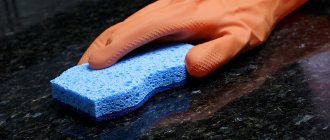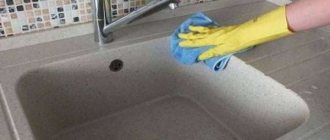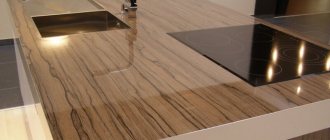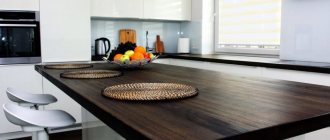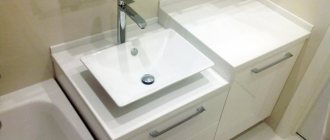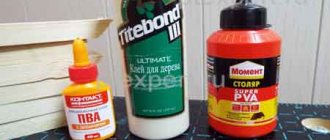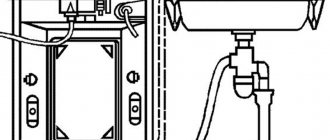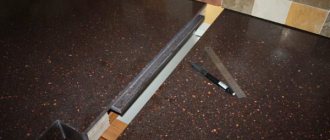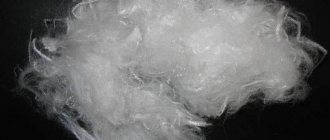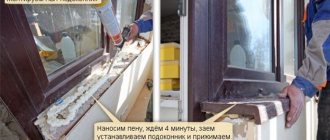Artificial stone is a practical and easy-to-care material used in the manufacture of kitchen countertops. But even on such a durable base, scratches and stains appear over time.
Polishing will help restore the surface to its former attractiveness. This is a simple and effective way to remove scratches, stains, and small chips. Such work is entrusted to a specialist or done independently using professional tools. You will find detailed information about polishing artificial stone countertops in this article.
How to polish an artificial stone countertop?
From our article you will learn how to polish an artificial stone countertop at home, as well as how you can do it yourself.
A countertop made of artificial stone is good because even when the surface is abraded, the pattern and color do not change. To give the surface its original appearance, it is enough to simply update the top layer instrumentally, more details. To make the work surface in the kitchen look more decent, polishing is considered the surest way. It is also the last stage before selling the finished product. Even the manufacture of countertops from granite, marble, wood or artificial materials involves this stage.
Repair methods
To achieve good results when carrying out restoration work, it is worth considering the nature of the damage.
Light damage
To remove small scratches or stains that cannot be removed, you should use a sanding machine equipped with an abrasive wheel. If there are chemical stains, burns or small scratches on the countertop, you can remove these damages yourself.
In this situation, professionals use a sanding machine equipped with a felt attachment. However, when performing repairs yourself, it is recommended to use a felt cloth.
If the surface is made of acrylic, you should be careful. In such a situation, grinding cannot be carried out
Application of glue
To restore the surface, it is worth purchasing a special repair kit. It should contain special products for puttying and repairing chips. To begin with, it is recommended to cut a groove in the structure of the tabletop. For this purpose, it is worth using a grinder equipped with a diamond blade. It is recommended to clean and degrease the surfaces around the area that needs to be repaired.
The top layer of acrylic powder should not be thrown away. It must be added to the polyester adhesive composition. It is recommended to degrease, deepen and expand the treated area. Then the resulting depression should be filled with special glue. It is recommended to choose it according to color scheme. After this, the excess substance should be removed.
What to do with large cracks
To restore a coating with large defects in the form of chips, it is recommended to use so-called patches. They must be made of the same material as the countertop itself. To begin with, it is recommended to cut out the problem area, and then place a part of the stone covered with glue into the resulting niche. Then this fragment should be polished. Thanks to this, it will not stand out. It is recommended to repair large damage on the stone surface with pieces of suitable material. It is glued inside, after which the surface is polished. Finally, it is polished.
Choosing the right material can be difficult, since there are many shades of coatings. Therefore, it is enough to choose an approximately similar tone. Moreover, after polishing, the glued fragment will not be very noticeable. This is due to the heterogeneity of the artificial stone.
The stores offer repair kits that contain crumbs of different shades, fillers and transparent glue with 2 components. It is worth considering that this method of restoring coverage is considered complex and requires appropriate skills.
Elimination of microcracks
Minor damage in the form of microscopic cracks or abrasions can be eliminated by sanding the surface of the countertop. It must be carried out by a professional. The first step is to use coarse sandpaper and remove most of the damage using a sander. Subsequently, it is recommended to complete the work using polishing paste and a special nozzle.
At first they are not noticeable, but after some time they increase in size, becoming more noticeable. This leads to a deterioration in the appearance of the stone coating. To get rid of microcracks, you should use a special glue that has an acrylic base. They should be used to fill the crack after treatment. At the final stage, it is recommended to sand the surface.
Polishing marble and granite countertops.
Is such a procedure really necessary and won’t it damage the stone, and will there probably be dirt? Sanding the surface of the countertop is necessary to remove scratches, stains, bald spots and scuffs on the stone. Simply “polishing” as our new customers ask will not work! Why?
Marble polishing is essentially a chemical process, although it essentially combines mechanical polishing with abrasives. If we take into account harder rocks, such as granite, basalt, then here too you cannot do without preliminary grinding.
In short, simply polishing will not remove scratches. Yes, the stone will look fresher, there will be more shine, but against this background, all defects will be more clearly expressed, in fact, this is money thrown away. If you want to save on polishing, we recommend simply using masking polishes for stone, this will be enough and the effect will be the same.
Restoration of chipboard facades
The front part of furniture made of chipboard can rarely be restored. Similar procedures for filling scratches, cracks and dents with furniture wax turn out to be ineffective. Because light hits the surface differently, it is impossible to make defects less noticeable. Usually they resort not to the restoration of damaged chipboard facades, but to the actual renovation of the entire facade part of the furniture:
- They are covered with wallpaper or covered with artificial leather. To do this, it is recommended to remove the facades and twist the handles - this will make it neater.
- They use photo printing, hand painting and decoupage techniques. The pattern can be applied exactly to the location of the defect, and not over the entire surface of the chipboard facade.
- The facade is decorated with self-adhesive moldings and various overlays. You can find out more about furniture decor here.
- Glue strips of melamine tape of a similar or contrasting shade. If you think through the concept, this disguise of damage can look like a design technique.
Required Tools
Before starting restoration work, you need to prepare the main tools and approximately determine the set of consumables. The main operation of restoring artificial stone is grinding - it will require an angle grinder, popularly known as an angle grinder.
It is used when repairing large surfaces, for example, when sanding an entire countertop. The work uses grinding wheels of different sizes.
If an angle grinder is at hand, you can use a regular electric drill. As a rule, special accessories for grinding are included with it; they are sold both individually and in whole sets. However, when working with a drill, it can be difficult to maintain a flat surface over a large area. This tool is only suitable for spot sanding small areas.
Depending on the nature of the deformation, wheel-type brushes, as well as a whisk or cup, may be required. Abrasive wheels can be hard or soft with abrasive grades from P120 (they are used for coarse grinding) to P1500 (suitable for fine grinding). For final polishing, use diamond wheels, as well as cotton or felt wheels. Mirror polishing at the final stage of restoration is performed using special pastes or polishing wax. As processing progresses, you will need to cool the surface from time to time - for this you will need a regular spray bottle with cool water.
Glossy or matte?
Depending on the type of surface, caring for countertops also has its own characteristics. The matte surface should be carefully cleaned in a circular motion using low-abrasive products, or use a soft sponge and soap solution. To remove stubborn stains, you can use fine sandpaper. To clean glossy surfaces, use only non-abrasive cleaners, such as bleach paste, applied with a soft sponge. If the gloss is damaged, you need to apply gloss paste to the damage, rub in and let dry. Then rinse with water. Artificial acrylic stone is a very stable and easy-to-use material that can be easily restored at home. If deeper damage occurs, you should contact a specialist.
Repair method using epoxy putty
Repairing cracks on hard surfaces with two-part epoxy filler can be faster, easier and more reliable than using superglue, especially when repairing wide cracks.
Gather all the necessary tools and supplies:
- denatured alcohol;
- two-component epoxy adhesive;
- several paints that match the base shade and stains on the countertop;
- several wooden ice cream sticks;
- several brushes and brushes;
- sanding discs and a couple of rags and sponges.
If you have a piece of the original countertop material, sand it down with a file and save it for later mixing with the filler. Proceed in the following order:
- Clean and degrease cracks with alcohol solvent.
- Place two drops of epoxy glue and hardener on a disposable surface. Take enough to fill the cracks.
- With a drop of glue, mix paint and/or shavings from the original tabletop material, bringing it to the desired color. Then mix with hardener.
- Apply epoxy glue to the cracks, spreading it with a wooden stick, and leave the filler slightly convex in relation to the tabletop.
- Look at the applied glue. If the color isn't quite right or is too thick to blend into the pattern, add a few drops of paint to match the stains on the countertop. Be patient, don't overdo it. Take a step to the side to get the overall impression.
- Allow the filler to cure according to the manufacturer's instructions.
- Once the filler has completely cured, begin sanding the surface with fine sandpaper.
Features of use
When working, you should always remember the speed. For example, if you alternately use AGShK 50 and AGShK 30, then in the first case the speed should always be higher, and in the second lower. To achieve the most mirror-like surface possible, step-by-step processing is necessary. You need to start with the largest grain and end with the smallest. It is also important to regulate the water supply. When working with a coarse grain disc, the water supply must be greater than when working with a fine grain disc. If the disc is intended for wet processing, it is strictly not recommended to use it dry. If you want to achieve a flawless appearance, finally treat the surface with a felt circle with diamond paste applied to it.
Don't know whether you need a 100 mm diamond flexible grinding wheel or a wheel of a different diameter? We recommend seeking advice from specialists. Errors in selection can lead to rapid failure of the diamond blade and poor quality of processing.
Tips for caring for products made of natural and artificial stone
Caring for natural stone products requires care and attention. Today, there are a large number of products for cleaning and maintaining the natural beauty of natural stone products.
Cleaning, care and polishing products for natural stone
- Mild shampoos for removing stains and daily care of natural stone;
- Special polishes that add shine to polished surfaces;
- All kinds of oil-repellent and water-repellent agents;
- Cleaners;
- Putty masses; Special putty mixtures are selected for a specific natural stone for the restoration of products (for example, restoration of cracks on the surface of the stone formed during its mechanical processing, which protects the cladding from the penetration of microorganisms);
- Wax protective coatings; Wax protective coatings improve the appearance of natural stone, protect it during use and allow treated stone coatings to be washed with ordinary water. Wax products that restore the shine of lost polished surfaces of natural stone products.
Today, the leading manufacturers of products for installation, protection, care and restoration of natural stone are: TENAX, MASTER-STONE, AKEMI, BELLINZONI, HMK.
Cleaning natural stone:
To clean natural stone, a solution with natural stone care products (“Wet cleaning”, “Gloss care”, produced by the German company Lithofin and Turkish) is suitable. Detergents dissolve and remove accumulated dirt, forming a protective layer on the surface, which subsequently facilitates the further process of caring for natural stone.
Cleaning heavily soiled natural stone:
If natural stone is heavily soiled (stains of limescale, traces of dirt or oil, soot or rubber, etc.), use alkaline cleaners that have a strong degreasing effect. For example, such as: “Intensive Cleaner”, “Cement Veil Cleaner”, “Basic Cleaner”, “Allex” - products of the German company Lithofin. In concentrated form, these products are applied pointwise; they easily remove traces of paint, “old” stains of coffee, oil, and even markers. When diluted, these products are used as detergents, opening the pores of natural stone for further treatment with protective compounds.
Protection of natural stone from chemical and mechanical influence:
To protect granite, marble, onyx from chemical and mechanical influences, from dirt, water, grease, drinks, moisture, and cosmetics, use universal polymer liquids that work both as protection and as a polish. Such products do not change the color of the stone or form a film, and when used correctly they do not leave any marks. These are such products as “Basic Protection”, “Spot Spot”, “Stone Strengthener”, “Color Enhancement” from manufacturers Lithofin, Tenax and Elkay. The undiluted composition must be evenly applied with a swab to the surface until the stone cladding stops absorbing liquid. After 15 - 20 minutes, the residue must be removed and the natural stone rubbed with a dry cloth to a mirror shine.
Water-, oil-repellent treatment:
HYDREX is a protective product ideal for water-, oil-repellent treatment of tables, countertops, window sills, as well as building facades made of brick, limestone, marble, granite, and other types of natural stone. Impregnating the stone, leaving a protective film on its surface. Ready-to-use silicone-based impregnation provides long-lasting protection against penetration of moisture, oil and grease. Suitable for exterior and interior use.
Tips for caring for stone: 1. It is necessary to systematically wipe the polished surface of the stone with a soft rag moistened with warm water and a mild detergent or a special product intended for caring for stone. Next, the natural stone product should be wiped with a dry cloth;
2. Do not use pastes, creams, or dry, powdered detergents. Such substances contain abrasive material that can scratch the polished surface of natural stone;
3. Do not mix bleach and ammonia to clean natural stone. This combination creates emissions that are toxic and dangerous to natural stone;
4. To clean marble or limestone, do not use detergents containing acetic, citric or other acid;
5. To prevent contamination of products made of natural stone, after cleaning it, the surface must be treated and polished using special wax.
6. Natural stone floor surface The main enemy of polished natural stone tiles laid on the floor is sand, which scratches the polished surface of the stone. Rugs inside and outside your home or office will reduce the amount of dirt and grit that won't spare the polish of your natural stone floors. It is not advisable to use a vacuum cleaner to clean a natural stone floor with a polished surface - metal, plastic or wheels of which can scratch the surface of the stone.
Update methods
How to update your kitchen countertops with your own hands? What are wood countertops in the kitchen covered with? Beginners have many questions and, as a result, difficulties in the restoration process, which plunge them into a stupor. Of course, any remodeling and restoration of kitchen furniture may ultimately not lead to the result that was originally planned. However, here you should remember that it’s never too late to get rid of your old table and buy a new one, but it’s still worth a try.
You can restore your kitchen table yourself or update it in the following ways.
- Painting through tulle involves painting the product with paint according to the stencil principle. To do this, the fabric is spread on the table in such a way that there are no tubercles. Next, you need to paint the entire surface using spray paint and let it dry, then remove the tulle. As a result, a beautiful lace pattern is formed on the table.
- Remodeling the table may involve restoration using ceramic tiles. This coating is not only attractive, but also practical, since it can withstand various types of influences. These can be whole blocks or multi-colored fragments in the form of a mosaic. If there are no tiles, glass shards can be used as restoration material.
- You can update an old table using self-adhesive film. Modern manufacturers offer inexpensive models with original designs. For restoration, it is enough to paste over the surfaces of the product - and it will be transformed before your eyes.
- If the table is made of solid wood, you can use the burning technique as an idea for restoration, but this requires certain work skills, as well as special equipment in the form of an electric burner.
- Decoupage is a very fashionable way to transform furniture and give it a completely different look. This does not require special artistic skills, because the basis is taken from ready-made photos on paper or a napkin, which are attached to the table.
Tabletop polishing process
Polishing the tabletop is carried out according to the principle from most to least. It is on this principle that an abrasive is selected for this type of work. In the first stages, coarse abrasive stone materials are used and reduced as needed.
Each stage of surface treatment lasts from ten minutes to one and a half hours. The time depends on the wear of the countertop, the number and depth of scratches. In addition, the time may vary depending on the type of surface required, and it can be matte, glossy or semi-matte. Accordingly, the final version of the abrasive is selected based on the type of surface required. The more glossy the surface is expected after polishing, the finer the abrasive used. For maximum gloss, use abrasive with numbers 1200-1500.
Kitchen countertops are rarely glossy, as they are often subject to mechanical stress from cutlery, knives, pots, plates and other kitchen utensils. As a result of such impacts, the glossy surface would quickly become covered with abrasions and scratches.
Matte countertops in light shades (such colors hide small scratches well) are much more practical in this regard, which is why they are more common. To polish a matte countertop, use abrasive number 240-260. For polishing semi-matte countertops, abrasive number 600-800 will be optimal.
Dark semi-matte countertops are also very popular and are considered quite practical.
Restoration of chipboard furniture: what you might need
- Soft furniture wax (wax putty). Used to seal chips, scratches, cracks on wooden and laminated surfaces of cabinet furniture, interior doors, laminate and parquet. Provides moisture resistance to the restored surface.
- Hard furniture wax (melt putty). Requires melting before use (for example, using a lighter, soldering iron or gas torch). Application is similar to soft furniture wax. Recommended for restoration of chipboard surfaces with high intensity of use (countertops, shelves, floor coverings).
- Retouching agents - felt-tip pens or alcohol-based markers, valve and fiber. With their help, the texture of the material at the restoration site after waxing is completed to make it less noticeable. Ordinary felt-tip pens in shades that match the furniture, strokes, paints, even shoe polish and iodine will also work.
- Fixing varnishes, polishes (best in the form of sprays and aerosols) for surface treatment after restoration. For coating after restoration of defects, returning surfaces to their former shine, masking abrasions and minor scratches.
- Melamine edging with adhesive for replacement trim.
- Two-component epoxy composition, PVA, dowels (chops), wooden plugs for filling holes from torn hinges and other fasteners.
- Tools – plastic spatula, sandpaper, abrasive sanding sponge (fine), utility knife, hair dryer or iron, chisel, non-woven wipes and rags for finishing.
General recommendations for caring for countertops
Artificial stone is a very durable material, but it requires compliance with certain rules of use that will help maintain its integrity and beauty.
To avoid a time-consuming repair process, it is best to prevent scratches, chips and stains.
Follow the recommendations of specialists for use and care, and it will not disappoint you and will serve for a long time. There are several reasons for the polishing of the surface array to fail:
- Do not place hot pots and pans on the countertop; use special trivets for hot items.
- If liquid gets on the surface, remove it immediately, do not allow the stain to dry, which will then be difficult to remove.
- Do not use powders and pastes with abrasive substances that scratch the surface for cleaning; it is better to use special cleaning products for stone.
- Avoid contact with various acids on the surface of the countertop - a reaction will occur with the polish, the stain will be absorbed into the stone and then grinding will no longer be necessary.
- In case of normal contamination, wash the countertop immediately, do not let it dry. If this happens, soak the stain with soapy water and wash with warm water and ammonia - ten drops per liter of water.
- When cleaning, use only soft cloths and sponges to avoid damaging the coating.
- For minor scratches and obvious marks on the surface, you can get by with a special impregnation that will partially restore the integrity of the stone.
When making repairs, follow our advice, then the procedure for restoring the beauty of your countertop will not be very tedious. And the stone surface will always delight the owner of the house with its natural beauty and ease of use.
How to properly care
A kitchen made of synthetic stone can last more than 15 years. How beautiful and new it will look after this period depends on how to care for the countertop, sink and other surfaces made of this material.
General rules
To preserve the beauty of artificial stone, you need to adhere to the following general rules:
- Remove all contaminants immediately. This is especially true for greasy marks. Used tea bags, fruit and vegetable peelings should not be placed on a light-colored stone to avoid staining. Spilled drinks should be wiped up immediately. It will be difficult to wash away stubborn dirt.
- Use a cutting board. The reason is indicated in the previous paragraph. This is also necessary to avoid damage. Artificial stone is durable, but it will not withstand a sharp, accidental blow with a knife.
- Maintain temperature. Do not place hot dishes on the countertop without a special stand. This will leave unsightly marks on the surface. It is not recommended to expose stone sinks, both in the kitchen and in the bathroom, to sudden fluctuations in water temperature.
- Use special means. There are compositions developed specifically for acrylic stone. If there are none, you can clean the surface with a soap solution or dishwashing liquid.
- Provide protection. To resist scratches, you can coat the countertop with a protective composition without wax or silicones. Varnish or other wood care products will do.
- Wipe dry . Water and other liquids will leave unsightly marks on the surface of the table, so it is better to wipe everything off at once.
When choosing the color of your future kitchen, you need to take into account that care will depend on it. White artificial stone is easily soiled, dirt is absorbed into it, and marks from hot dishes are noticeable. Black and colored will indicate the slightest dust, scratches, signs of wear.
What can and cannot be washed
The best option for caring for such a countertop is regular washing with a soapy sponge. However, soap is not able to cope with stubborn stains. It’s easy to get confused in the variety of household chemicals.
Therefore, you need to know what means to wash synthetic stone:
- liquids and gels for washing dishes;
- non-abrasive chlorine cleaning pastes;
- fat-dissolving non-aggressive kitchen products.
When using them, you must follow all the manufacturer’s recommendations and not violate the specified exposure periods.
List of products that cannot be used to clean artificial stone:
- metal cleaning preparations;
- aggressive acid and alkaline compounds;
- products containing methylene chloride;
- paint solvents;
- products containing acetone.
In addition, coarse abrasives are prohibited. Cleaning powders with large particles, hard sponges, wire brushes and scourers leave scratches on the surface of the countertop that will have to be removed.
Important! When choosing a cleaning product for acrylic stone countertops, carefully read the composition! Aggressive chemical compounds can damage the surface.
Folk remedies for stubborn stains
Home remedies will help remove stubborn, stubborn dirt:
- white 5% wine vinegar, diluted twice with water, will remove grease, dirt, water stains, and limescale;
- dry mustard powder is suitable for daily washing and degreasing of surfaces;
- lemon juice and citric acid are used to clean the table from traces of rust and limescale, stains from coffee, tea, wine;
- a solution of table vinegar will remove stains from sweet soda, limescale and rust;
- a paste of baking soda and water will degrease and disinfect the table, lighten it and gently polish it;
- Toothpaste will remove small stubborn stains, grease and dirt.
Before using any folk remedy, you should test it on a small and inconspicuous area. The material may behave differently depending on the color, resin used, adhesive and other factors.
Vinegar and citric acid should not be applied and left on for a while. Acids are only suitable for wiping the stone and then washing it with clean water.
A few words about polishing
Even with impeccable care for an artificial stone countertop, it will fade over time, lose its glossy shine, and become rough and matte. This is natural wear and tear of the material. At the same time, the strength is maintained and the table performs all its functions.
To restore beauty and extend the life of the kitchen, artificial stone needs to be polished periodically.
Polishing is carried out using special pastes. These products contain abrasives, but without large and coarse particles. The composition is applied to the surface of the stone and rubbed in with soft circular movements. After this, the material returns to its gloss, shine, smoothness and original appearance.
